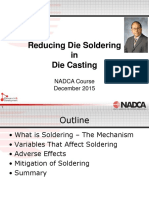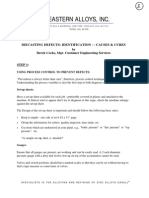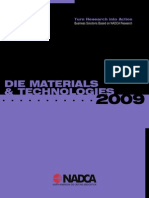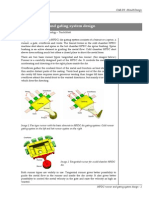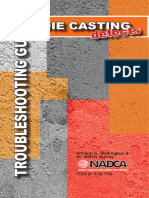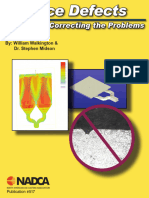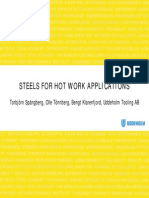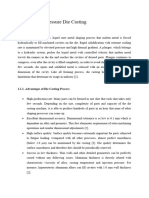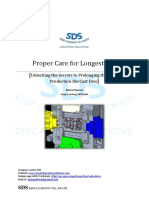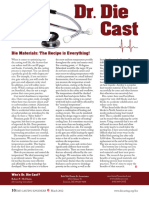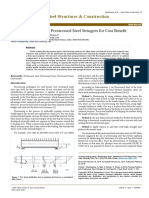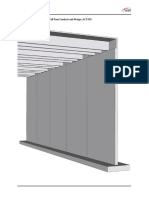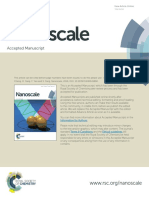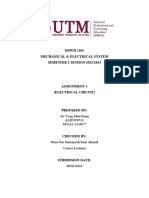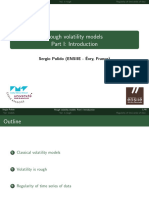Uddeholm Tooling AB
HPDC
�HPDC
Failure Mechanisms
�Failures in casting applications
Heat checking Gross cracking Erosion Corrosion/soldering Indentations
Bengt Klarenfjord
�Influencing parameters on die life
MATERIAL DESIGN DIE MANUFACTURING HEAT TREATMENT DIE CASTING MACHINE Machine characteritics Vacuum Pressure Process settings PRODUCTION MAINTENACE
Basic die material properties Hardness Temper resistance Hot yield strength Creep strength Ductility Toughness Thermal conductivity Thermal expansion
Sizing Die/Inserts Fillets/holes/ cornes Cooling channels Runners/gat es/overflows
Machining EDMing Polishing Welding Stress relieving
Preheating Austenitizing temperature and time Quenching Tempering Surface treatment
Process control Preheating Die temperature Cast metal/compositi on/temperature Cooling Lubrication Mechanical loads
Cleaning Shot peening Stress tempering Welding
Bengt Klarenfjord
�Heat checking
Caused by a combination of thermal cyclic stress, tensile stress and plastic strain
5
Bengt Klarenfjord
�Causes for early heat checking
Material Design Die making Heat treatment/surface treatment Production
Bengt Klarenfjord
�Temperature and stress distribution in the die surface
Temperature Tensile stresses
Temperature Compressive stresses Stresses
The cooling cycle on the die surface plays a critical role in the heat checking mechanism
7
Bengt Klarenfjord
�Heat checking model
Bengt Klarenfjord
�Causes for early heat checking - Material
Low ductility Low hot yield strength
Bengt Klarenfjord
�Microstructural influence on the ductility
10
Bengt Klarenfjord
�Impact strength as a function of the number of primary carbides >4 m
11
Bengt Klarenfjord
�Choose a tool steel of the highest quality
12
Bengt Klarenfjord
�Test certificate
Chemical composition Microcleanliness Annealed microstructure and hardness As quenched hardness and grain size Impact toughness Ultrasonic inspection
13
Bengt Klarenfjord
�Heat checking resistance
A good ductility increases the resistance to heat checking
14
Bengt Klarenfjord
�Heat checking resistance
220
20-700 C/air/800 cycles
200 180
DIEVAR ORVAR SUPREME
T A =1025 C/30min
Maximum crack depth (um)
160 140 120 100 80 60 40 20 0 40 42 44 46 48
50
52
Hardness (HRC)
15
Bengt Klarenfjord
�Causes for early heat checking - Design
Cooling channels too near the die surface Stress raisers
16
Bengt Klarenfjord
�Use sufficient distance between cooling channels and cavity surface
17
Bengt Klarenfjord
�Causes for early heat checking Die making
EDM layer at the surface Weld repaired surface Higly polished surface Grinding marks Non-oxidized surface Insufficient machine stock
18
Bengt Klarenfjord
�Avoid EDM- layer on the die cavity surface
Conventional machining Hardening and tempering Initial EDM, avoiding arcing and excessive stock removal rates. Finish with finesparking, i.e.low current, high frequency Grind or polish EDM surface Temper the tool at 15-25C lower than the original tempering temperature
19
Bengt Klarenfjord
�Grinding marks in the radius
20
Bengt Klarenfjord
�Causes for early heat checking Heat treatment/surface treatment
Low hardness
Poor hardend microstructure
Decarburization Too thick a nitrided layer
21
Bengt Klarenfjord
�Heat checking test
Test area
Fixed part 210 x 475 x 570mm
22
Moving part
230 x 475 x 570 mm
Bengt Klarenfjord
�Result from heat checking test
16 Vidar VIDAR 14 12 Orvar ORVAR Dievar DIEVAR
Crack Rate %
10 8 6 4 2 0
50.000
71.000
186.000
25.000 140.000 Gross-Crack
38
44
49-50
50
HRC
23
Bengt Klarenfjord
�Very sharp edges
Crack
24
Bengt Klarenfjord
�If inserts are to be nitrided, avoid too thick a nitrided layer
Recommendations Inserts Cores Shot sleeves max. 0.05 mm max. 0.1 mm max. 0.3 mm
25
Bengt Klarenfjord
�Causes for early heat checking Production
Insufficient preheating of the die Preheating the die with a gas torch Short cycle times High melt temperatures High injection speeds Excessive spraying of the surface Very cold cooling media
26
Bengt Klarenfjord
�Preheat the die in a proper way and to a high enough temperature
Preheating Range
Impact strength
DIEVAR QRO 90 SUPREME ORVAR SUPREME
Working temperature for the die: Zn 150-200C Mg 200-250C Al 180-300C Cu 300-350C High temperature for thin parts. The preheating temperature 30-50C below the working temperature.
100
200
300
400
500C
27
Bengt Klarenfjord
�Do not spray lubricant for a longer time than necessary
Use intermittent spraying
28
Bengt Klarenfjord
�Stress temper the die after the running-in period and routinely throughout production
After the running-in period After 1000-2000 shots After 5000-10 000 shots After 10 000-20 000 shots and then continuously
29
Bengt Klarenfjord
�Gross cracking damage
Temporarily thermal or mechanical overloading of the die
30
Bengt Klarenfjord
�Causes for gross cracking
Material Heat treatment Die making Die casting process Maintenance
31
Bengt Klarenfjord
�Use inserts
32
Bengt Klarenfjord
�Have sufficient material in the die
A depends on machine size
Machine Size
A 4.000 7.000 12.000 20.000 32.000 80 90 100 120 140 to to to to to 90 100 120 140 160 mm mm mm mm mm
A = Wall thickness of insert B = Wall thickness of holder
A B
Insert Holder
kN 2.000 to kN 5.000 to kN 8.000 to kN 13.000 to kN 21.000 to
B (holder) = 1,2 x A
Note: small dies should never be used in big machines (bending danger of columns)
33
Bengt Klarenfjord
�Use adequate fillet radii
Impact strength, J
35 30 25 20 15 10
Fillet radii Zinc >0,5 Aluminum >1 Brass >1,5mm
0.25
0,75
1,25
1,75 mm Radius
34
Bengt Klarenfjord
�Have sufficient material after rough machining for making a proper heat treatment
ORVAR SUPREME Hardened in a vacuum furnace Dim: 250 x 200 x 300mm Hardness: 44HRC
Impact strength, KV, J
50 40 30 20 10 100 200
1,5 bar 4,5 bar
300
Testing temperature C
35
Bengt Klarenfjord
�Toughness as a function of quench rate ORVAR SUPREME, 44 46 HRC
Charpy V, J C/min 800 - 500C
25 20 15 10 5 0 9,5
36
15
23
34
66
600 C/min
Bengt Klarenfjord
�Reduce plunger velocity in the start-up process
The first 5-10 shots with reduced velocity
37
Bengt Klarenfjord
�Cool the die in a proper way
* If cooling with water, preheat the water to 40 - 50C * Adjust the cooling during production stops. * Do not turn on cooling media while the die is hot.
38
Bengt Klarenfjord
�After maintenance of the die
Stress temper when weld repair has been carried out
39
Bengt Klarenfjord
�Erosion damage
Hot wear of the cavity surface
40
Bengt Klarenfjord
�Causes for erosion
Hot hardness of the die material Lubrication of the die Velocity of the cast metal ( gate section, velocity of piston ) Temperature of the cast metal Chemical composition of the cast metal ( type of alloy ) Surface treatment
41
Bengt Klarenfjord
�Do not use too high an injection velocity
42
Bengt Klarenfjord
�Filling time
Depends on:
* Wall thickness of part * Range of liquid - solidification temperature of metal alloy AlSi9Cu3 490 - 600 C (110C) AlSi12 565 585 C ( 20C) AlSi12(Cu) 570 585 C ( 15C) AlSi10Mg 550 610 C ( 60C) * Die temperature
Wall thickness part mm
43
Bengt Klarenfjord
Filling time ms
�Corrosion
In cases where the cavity surface lacks a protective layer, the cast metal will diffuse into the die surface. At the same time, alloys esp iron will diffuse from the die surface into the cast metal. These processes create intermetallic compounds between the cast metal and the die surface
Steel Fe2Al5 FeAl3 Al-Alloy
44
Bengt Klarenfjord
�Corrosion / erosion damage in a die
45
Bengt Klarenfjord
�Corrosion damage in shot sleeve
46
Bengt Klarenfjord
�Behaviour of corrosion / erosion as a function of the flow velocity of the melt
Corrosion / erosion rates
Flow velocity of the melt
47
Bengt Klarenfjord
�Soldering
The cast metal has soldered to the die surface because of severe formation of intermetallic compounds
48
Bengt Klarenfjord
�Results from investigation of water jacket inserts
Simulation study Investigations of dies
49
Bengt Klarenfjord
�50
Bengt Klarenfjord
�51
Bengt Klarenfjord
�Problem with soldering at a water jacket
52
Bengt Klarenfjord
�PVD surface treatment, Ti Al N, 5 m
53
Bengt Klarenfjord
�Causes for soldering
Direct contact between melt and steel. No protective surface layer. Bad conditions during lubrication. Die temperature too high. Melt temperature too high. Low Fe content in the Al melt.
54
Bengt Klarenfjord
�Surface temperature
Depends on:
* Metal temperature and heat capacity * Cavity contour and die design-wall thickness, cores * Preheating temperature * Frequency of cycles * Condition of die filling * Die internal cooling * Cast system (gate, runner, bush)
Good heat transfer
Bad heat transfer Note: A surface temperature higher or lower than 20 C may decrease or increase the die life by 30 to 50 %
55
Bengt Klarenfjord
�Improve cooling by a Cu-bar
In narrow areas use Cu-bar connected to a cooling channel
Cu-bar
56
Bengt Klarenfjord
�Positioning of cooling channels
57
Bengt Klarenfjord
�Positioning of cooling channels
Unfavorable design
Favorable design
* * * * *
58
Better to have more small cooling channels than a few big ones When using water, 9 to 12 mm; when using oil, 12 to 15 mm Distance cooling channel to cavity in general 25 mm Cooling channel depending on wall thickness of the part Distance of cooling channels, max 3 x
Bengt Klarenfjord
�Bad conditions during lubrication
Uneven die temperature the release agent moves from warmer to colder areas. Too high a die temperature at certain areas the temperature at the die surface should be below the Leidenfrost point ( the wetting temperature ) during lubrication which means a good adherence for the release agent. Too low a die temperature at certain areas means less evaporation of the water in the lubricant and a bad adherence for the release agent.
59
Bengt Klarenfjord
�Temperature
Lubrication
Time
60
Bengt Klarenfjord
�Some other things influencing the quality of the lubrication
Too hard spraying means problem with evaporation and the adherence for the release agent will be bad. Too long spraying means that the release agent can be washed away. ( These two things also mean an over-cooling of the die ).
61
Bengt Klarenfjord
�Increased Leidenfrost point
Different aditional materials in the release agent can decrease the surface tension of the droplets which means an increase of the Liedenfrost point a higher wetting temperature.
62
Bengt Klarenfjord
�Some more results from laboratory tests:
A rough surface was found to increase the wetting temperature. The application pressure was found to influence the result. The striking energy of the droplets become low at distances over 100 mm at a pressure of 5 bar.
63
Bengt Klarenfjord
�Surface protection
It has been found that a nitrided surface not always is good enough for avoiding soldering. This means that a suitable surface treatment must contain substances having a low solubility in molten aluminium and with a low tendency to form intermetallic phases between the steel and the aluminium melt. The layer should therefore contain substances like Nb, V, Ti, W, Mo or Cr and their carbides or nitrides.
64
Bengt Klarenfjord
�Duplex layer which has shown good results against soldering.
Ti Al N
Ionic nitriding
Steel
65
Bengt Klarenfjord
�Causes for corrosion/soldering
Temperature of the cast metal and die Chemical composition of the cast metal Velocity of the cast metal Surface treatment of the die Lubrication
66
Bengt Klarenfjord
�Avoid too highly polished surfaces
A highly polished surface results in poor adhesion of the lubricant during the running-in period.
67
Bengt Klarenfjord
�Oxidize the cavity surfaces
500
68
735
950C
Bengt Klarenfjord
�Use a melt temperature not higher than is necessary for the quality of the product
69
Bengt Klarenfjord
�After maintenance of the die
Do not start the production with shiny surfaces
70
Bengt Klarenfjord
�Indentations
Indentations in the parting lines or cavity surface are due to too low a hot yield strength. The hot yield strength of the steel decreases as the temperature increases. Thus, the risk of indentations are are higher at elevated working temperature.
71
Bengt Klarenfjord
�The die life depends on several parameters
Material Design Die making Heat treatment/surface treatment Production
72
Bengt Klarenfjord
�Important die steels properties
Temper resistance Hot yield strength Creep strength Coefficient of thermal expansion Heat conductivity Ductility / Toughness
73
Bengt Klarenfjord
�Important die steel properties
A good temper resistance means a good resistance against softening at high temperatures. A good hot yield strength lowers the plastic strain. A good creep strength improves the resistance to fracture at high temperatures and mechanical loading. A low coefficient of thermal expansion means less expansion and contraction between the surface and the core of the die and therefore, lower thermally induced stresses. A good thermal conductivity reduces the thermal gradient and thus the thermally induced stresses. A good ductility increases the ability of the die steel to absorb plastic strain without cracking. A good toughness increases the ability of the die steel to absorb tensile stresses in sharp notches before a fracture occurs.
74
Bengt Klarenfjord
�TRUST IS SOMETHING YOU EARN, EVERY DAY.
